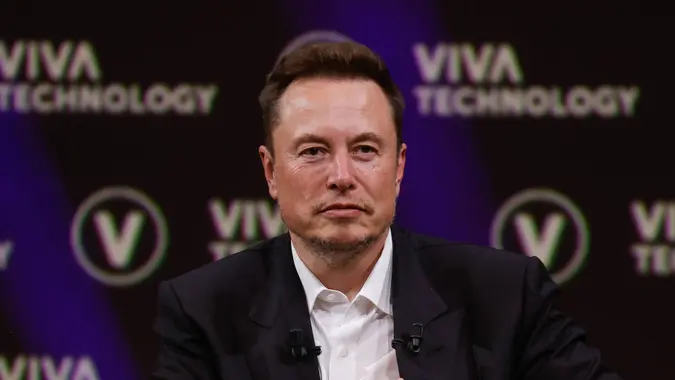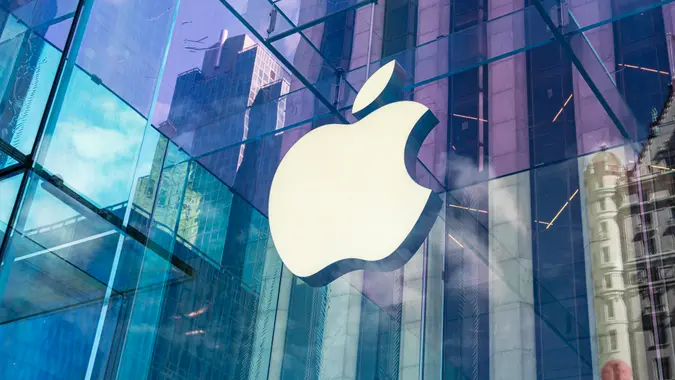Time To Panic? What Experts Advise for Tesla Investors Amid Stock Slide

Commitment to Our Readers
GOBankingRates' editorial team is committed to bringing you unbiased reviews and information. We use data-driven methodologies to evaluate financial products and services - our reviews and ratings are not influenced by advertisers. You can read more about our editorial guidelines and our products and services review methodology.

20 Years
Helping You Live Richer

Reviewed
by Experts

Trusted by
Millions of Readers
Tesla’s stock price has collapsed over 50% since its high of $488.54 in December 2024. Is now a great time to “buy the dip,” or does the price have further to fall?
Most investing analysts agree: the stock remains overvalued, even after its recent tumble. Here’s why you should consider selling your Tesla stocks.
Cash Flow Ratios
By every conventional metric, Tesla looks overpriced — and that starts with cash flow.
Tesla’s price-to-cash flow ratio is an astronomical 65.33, as reported by MarketWatch. For context, General Motors (GM) has a price-to-cash flow ratio of just 2.35.
“Every investment is the present value of all future cash flows,” said Paul Gabrail, founder and host of Everything Money. “The question is, can Tesla’s future cash flows grow enough to justify a $766 billion valuation? Right now, Tesla is selling for 250X free cash flow. That’s hard to get around even if cash flow grows at 20% per year.”
P/E Ratios and Other Metrics
Currently, Tesla’s price/earnings ratio sits at a dizzying 122.64. Compare that to a historical average for the S&P 500 of around 15.
“A value investor wouldn’t touch the shares, even after the recent pullback,” explained Robert R. Johnson, finance professor and CEO of Economic Index Associates. “Tesla currently sells at a price-to-sales ratio of 8.95 and a price-to-forward earnings ratio of 88.02. These are astronomically high compared to Ford and GM.”
Ford currently sells at a price-to-sales ratio of 0.21 and a price-to-forward earnings ratio of 7.15. Similarly, GM currently sells at a price-to-sales ratio of 0.29 and a price-to-forward earnings ratio of 4.20.
The case to buy or even hold Tesla stock requires investors to ignore the numbers entirely, and solely invest based on the narrative that Elon Musk is a genius and that Tesla will dominate electric vehicle sales in the 21st century.
Alienated Consumers, Plummeting Sales
In February, Tesla’s sales in China fell 49.2% from a year earlier, reported Reuters. And it doesn’t get prettier from there.
“Musk’s involvement in the Trump Administration has angered a huge share of Tesla’s potential market for electric vehicle purchasers,” said Johnson. Protests against Musk and Tesla have exploded over the last month, both in the U.S. and abroad.
“Protests aside, sales are falling off a cliff in Germany. I believe the shares were dramatically overvalued even before the recent political firestorm facing Tesla,” he said.
Rising Competition
Even as many would-be buyers at home and abroad boycott Tesla, the EV maker faces increasingly stiff competition from other automakers.
Reuters reported that China’s BYD saw a 90.4% increase in car sales in February. Chinese automakers aren’t the only ones challenging Tesla’s former dominance — Ford and General Motors also recorded rising EV sales in 2024, while Tesla’s sales declined, according to the Detroit Free Press.
“Slowing demand, margin compression from price cuts, and rising competition from legacy and Chinese automakers all add to Tesla’s woes,” said Fei Chen, investment banker and CEO of Intellectia AI.
Poor Reliability
There are the stock metrics, there are the headlines, there are the narratives. And then there’s the product itself.
Tesla’s cars break down more than most of their competitors. The latest reliability rankings by Consumer Reports put Tesla 17th out of 22 car brands. Poor reliability, coupled with dated designs, has hurt Tesla’s brand in recent years.
Is There Any Case To Buy?
Some long-term Tesla bulls make the case that Musk and Tesla will eventually overcome all these hurdles through ingenuity.
To be fair, they do retain a few advantages. “The company remains a technology leader in EVs, artificial intelligence, and energy storage,” said Chen. “But with the premium valuation of the stock, waiting for more concrete evidence of revenue growth or stabilization of margins might be the wise thing to do.”
 Written by
Written by  Edited by
Edited by 
























